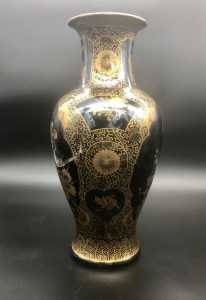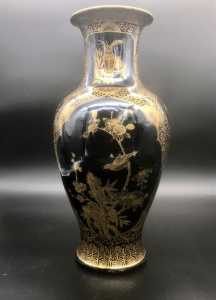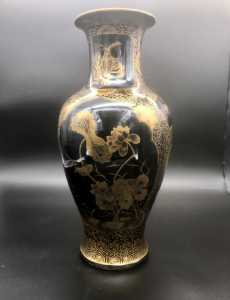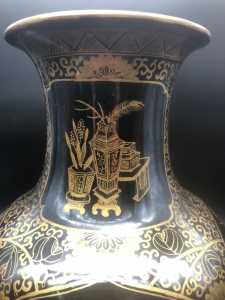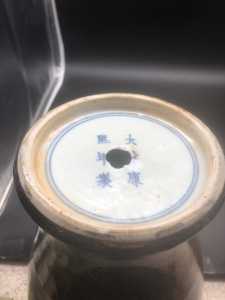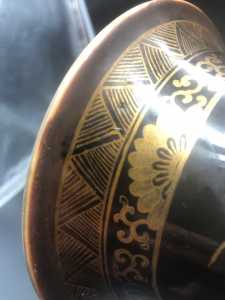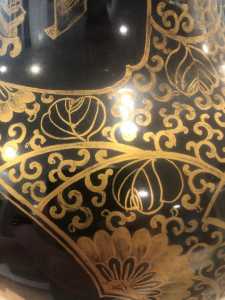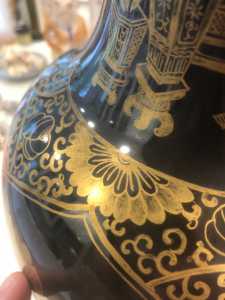The Chinese and Asian Art Forum. For Fans, Collectors and Dealers.
 Basic Rules For the BidAmount Asian Art Forum: Talk about whatever you want. You can even discuss and offer things that are for sale if they are authentic. Maximum image file size per post is 2 MB. Images of 700pxl x 700pxl are optimal if saved at a medium resolution. Be respectful of others and enjoy yourself. Click the YouTube link for a brief tutorial on using the forum. You can also EMBED Videos by cutting and pasting from You-Tube, Vimeo etc.
Basic Rules For the BidAmount Asian Art Forum: Talk about whatever you want. You can even discuss and offer things that are for sale if they are authentic. Maximum image file size per post is 2 MB. Images of 700pxl x 700pxl are optimal if saved at a medium resolution. Be respectful of others and enjoy yourself. Click the YouTube link for a brief tutorial on using the forum. You can also EMBED Videos by cutting and pasting from You-Tube, Vimeo etc.
NOTE: To post an item or add a new post, click open the category title from the FORUM LIST, and CLICK the Blue ADD TOPIC button.
Hi all, so as promised here is the lamped Mirror black vase. I was hoping and praying it was as flawless as it turned out to be. I suspect it is earlier than initially I thought (19th rather than 20th). The gilding is virtually flawless, two small spots of rubbing. The rim thins to brown, and the base has a Kangxi mark. It is also a whopping 17" tall. what do you all think?
-Jeremy
p.s. sorry for the limited lighting, it barely fits in my photo light box.
I don’t see any glazed chipped from the base? Gilding looks burnished can you verify this?
Look at the flower see all those lines in the gilding running one direction that looks burnished to me. Burnished gilding tend to be on earlier gilding due to the fire gilding process leaves the gild dull it is burnished with a agate tool to bring that gold luster back.
Jeremy,
Your vase is very nice and in great condition. I really like it. Unfortunately, I know nothing about these wares, but I hope it turns out to be earlier, as you suspect. Will be following closely!
@lotusblack,
Do you mind sharing where you've learned about gilding methods? You mentioned it in passing on one of my bowls, and I've been curious ever since.
Kindly,
John
Interesting, I do see the lines, I assumed that might be wear. As far as the foot there isn't much chipping but it appears to be ground, and I think the early ones the glaze ends neatly, but honestly I cannot find much detailed info on the mirror-black glazed pieces.
-Jeremy
@jbeer2121 I wonder if the grind down the lip. I’m not saying it’s Kangxi the base and shape don’t seem just right. But the gilding places it before late Qing second half of 19th century gilding practices changed and new gild in that period didn’t need burnished.
Perhaps around 1800-1850s which I think is around the time the gilding methods change to powdered gold paint?
-Jeremy
@bartholin I had a bowl myself with dating issues so I started with research on gilding from French pieces Porcelain furniture etc because Chinese gilding of the same period was hard to come by. After I noticed gilding practices changed I went to every antique store and collection that would let me look at their pieces under a loop. I noticed that older forms of gilding needed burnished and later pieces didn’t but one feature I did notice about earlier gilding and modern was the gold purity. The older the piece the purity of gold was noticeable under a loop looks like little micro balls very low to no alloys modern gild is loaded with everything the more the rainbow the later it is. The transitional time the gold has a halo where the powered method is used.
Thanks for the thorough explanation.
That is super interesting and of course I have been obsessing over a handful of my gilt decorated things with a loupe trying to assess the type of gilding. Interestingly the french pieces, which are mostly early 19th century seem to have more than gold mixed in and its rather granule and compared to this vase, which is definitely burnished, far less refined. An early Caughley teapot I have is definitely powdered gold suspended in a clear "enamel?"and has a halo effect of sorts.
Learn something new every day...
-Jeremy
I’m no expert but I figure there is science to old gilding practices and current. If burnished I start thinking old the powder gold enamel I see that a lot in late 18th mid 19th the rainbow stuff 19th century the shiny 20th century. When I shopping if I see something burnished I just buy it if cheap.
I went to a dinner last night with a very prominent local Japanese antique dealer and he and his wife both collect Chinese and Japanese pieces, we had an interesting discussion on gilding as he sees dating pieces, I can confirm that you are spot on with you line of thought on the date ranges as it aligns perfectly with what he has seen over his 50 plus year career. I did bring the vase along with a few other pieces and he thinks it fits right in with mid 19th century, thought the gilding being burnished may suggest slightly earlier.
-Jeremy
I can not contribute to the methodology of how gilt mirror black vases are made. However, as the mark indicates, the style originates from the Kangxi, similar to Famille Noir. Mid Qing, the style mostly lost popularity, so there are really not that many examples from the late 18th to early 19th c. However, that changes in the late 19th c. during the revival of Kangxi style porcelains.
This is the likely dating of your vase. The better attention to the foot ring, large size, and use of a six character mark instead of just the double rings (or no mark at all) simply suggests that it was made with more care, and not that it is any older than the more rushed/sloppy examples of the same late 19th c. period.
Dear Jeremy,
I too am not a real expert, but I am sure that the lines seen on the gilded areas (especially on the petals of the flowers) has nothing to do with burnishing. If the Japanese expert said that, he is wrong.
Burnishing the gold gilding with agate will not produce lines; rather on the contrary, it would remove them.
The action of burnishing is making the surface of the gilding perfectly smooth and even, which will increase light reflection.
It is true that it was in use in older times, because it is associated with gilding through melting the gold powder in mercury, but it is not the case of your vase.
Your vase is not Kangxi, the base/foot is excluding that, as is also the appearance of the gilding.
At the same time, the appearance of the gilding is also excluding that it is a second half of 20th century onwards.
Hence, it should be late 19th/early 20th century. Kangxi revival as said by others.
Regards
Giovanni
Thanks for the reply, and I do agree that it is more likely to be Kangxi Revival and the quality is just better than average. I actually found a very similar one that was late 19th century.
I also what to thank you, for the gilding explanation and it makes sense that the burnishing would remove the lines rather than make them. I should note that I cannot recall if he described the vase's gilding as burnished, and more likely he would not have been mistaken and it is I who misunderstood.
Any ways thank you both.
Jeremy
Thanks for visiting "The BidAmount Asian Art Forum | Chinese Art"
If you sell on eBay, or have a shop feel free to post images and descriptions and links.
Check back often for discussion about the latest news in the Chinese art and antique world. Also find out about the latest Asian art auctions at Sotheby's, Christie's, Bonhams and Tajans.
Auction results for: fine porcelain, ceramics, bronze, jade, textiles and scholar's objects. As well as Japanese, Thai, Vietnamese and other Asian cultures.
Thank you,
Peter Combs
Topics and categories on The BidAmount Asian Art Forum | Chinese Art
Kangxi vases, Kangxi dishes and chargers, Kangxi ritual pieces, Kangxi scholar's objects, Qianlong famille rose, Qianlong enamels, Qianlong period paintings, Qianlong Emporer's court, Fine porcelain of the Yongzheng period. Chinese imperial art, Ming porcelain including Jiajing, Wanli, Xuande, Chenghua as well as Ming jades and bronzes.
The BidAmount Asian Art Forum | Chinese Art
A free Asian art discussion board and Asian art message board for dealers and collectors of art and antiques from China, Japan, Korea, Thailand, Cambodia, Vietnam and the rest of Asia. Linked to all of the BidAmount Asian art reference areas, with videos from plcombs Asian Art and Bidamount on YouTube. Sign up also for the weekly BidAmount newsletter and catalogs of active eBay listing of Chinese porcelain, bronze, jades, robes, and paintings.
The art of calligraphy - and for the ancient Chinese it certainly was an art - aimed to demonstrate superior control and skill using brush and ink. Calligraphy established itself as one of the major Chinese art forms during the Han dynasty (206 BCE - 220 CE), and for two millennia after, all educated men were expected to be proficient at it.
The Museum’s collections of Asian art span nearly five millennia and encompass the cultures of China, the Himalayas, India, Japan, Korea, and Southeast Asia. In 2007, the Museum launched an initiative to create dedicated galleries for the collection, beginning with a gallery for the arts of Korea ...
Chinese art is full of symbolism, in that artists typically seek to depict some aspect of a totality of which they are intuitively aware.
China Online Museum is the finest online museum of Chinese art. It features Chinese calligraphy, painting, ceramics, bronzes, carving, and other artworks.
Chinese Ceramics & Works of Art. Overview Upcoming auctions Contacts Auction results ... Christie’s sales of Chinese ceramics and works of art showcase centuries of Chinese history. Held throughout the year in London, New York, Paris and Hong Kong, they attract a wide audience of collectors and connoisseurs vying for pieces as diverse as ...
Explore Asian Art Week. Contact the Specialist Department. Chinese Paintings ... Senior Specialist, Head of Sale. [email protected]. Tel:+1 212 641 5760. Bid in-person or online for the upcoming auction:Fine Chinese Paintings on 10 September 2019 at New York. Bid in-person or online for the upcoming auction:Fine Chinese Paintings on 10 ...
Discover an abundance of must-see art from all corners of a vast continent at Christie’s NY Asian Art Week. From contemporary classical and Chinese paintings to works with exemplary provenance from the Art Institute of Chicago, our Rockefeller Paza galleries will be full of ancient treasures and contemporary masterworks in a salute to the vibrant arts of Asia.
Sold to benefit The Art Institute of Chicago’s Asian Art Acquisition Fund, the sale features 84 lots with a focus on Ming and Qing porcelains, and offers a rare insight into the taste for collecting Chinese ceramics and works of art in the Midwest from the end of the 19th century through the 1980s. Highlights include two Wanli wucai garlic-head vases, a Qianlong mark and period, blue and ...
Specialist, Chinese Paintings, Christie's London Dr Malcolm McNeill is a Specialist in Chinese Paintings at Christie’s, based in London. He previously worked as an assistant curator of the Chinese collections and the Victoria and Albert Museum in London, as a researcher at the British Museum, and as a translator and tour guide at the National Palace Museum in Taipei.
The Christie's Education 2020 Conference: The Chinese Art Market 18 Jun 2019 Christie’s Education is delighted to announce our first international academic conference in Asia which will take place in Hong Kong from 26-27 November 2020 at the Hong Kong Convention and Exhibition Centre and will run in parallel with Christie’s Hong Kong Autumn Auctions.
The summer Chinese Art sale in Hong Kong will feature works of art from several private collections, including Qing porcelains and textile from the collection of the legendary Chinese art dealer A. W. Bahr (1877–1959), fine gilt bronze Buddhist sculptures from an old Hong Kong collection, an East Asian collection of Qing dynasty wine cups and jades, and a Japanese collection of Song ceramics ...
Sotheby's Chinese Works of Art Department holds two auctions each year in London, New York, Hong Kong and Paris.
Chinese Art - View Auction details, bid, buy and collect the various artworks at Sothebys Art Auction House.
With more than 340 Chinese works of art dating from the Neolithic to the Republic periods, highlights of this sale include a selection of Qing Imperial monochromes from the collection of Arnold and Blema Steinberg, early ceramics from the Art Institute of Chicago and Chinese porcelain and works of art from the collection of Henry Arnhold.
Results: Sotheby's Asia Week achieved $52.4 million in six strong auctions, exceeding pre-sale estimates. With 76.5% of lots sold and 60.3% of lots surpassing high estimates, the Asian art sales at Sotheby's indicate continued collector interest in the finest works of art from China, India and and the Himalayas.
Today's sale of Important Chinese Art will proceed as planned with sessions at 10 AM and 2 PM EDT. Sotheby's will be monitoring the weather conditions throughout the day and will be available to coordinate alternative bidding options should conditions make it difficult for clients to attend the auction in person.
Bonhams Chinese Art department is renowned for offering the finest works of art representing the richness and breadth of China's artistic heritage, particularly Imperial porcelain, white and spinach green jades, cloisonné and Buddhist art. Specialised international auctions are held globally, including London, Hong Kong and San Francisco.
Bonhams : Chinese Works of Art We use cookies to remember choices you make on functionality and personal features to enhance your experience to our site. By continuing to use our site you consent to the use of cookies. Please refer to our privacy and cookie policies for more information.
Bonhams Fine Art Auctioneers & Valuers: auctioneers of art, pictures, collectables and motor cars. We use cookies to remember choices you make on functionality and personal features to enhance your experience to our site. By continuing to use our site you consent to the use of cookies. ... Chinese Art (US) General enquiries
Bonhams : Fine Chinese Art We use cookies to remember choices you make on functionality and personal features to enhance your experience to our site. By continuing to use our site you consent to the use of cookies. Please refer to our privacy and cookie policies for more information.
Bonhams Fine Art Auctioneers & Valuers: auctioneers of art, pictures, collectables and motor cars Bonhams : Asian Art We use cookies to remember choices you make on functionality and personal features to enhance your experience to our site.
Bonhams are international auctioneers of fine Chinese and Japanese art. We specialise in rare Imperial and Export Chinese ceramics and works of art, as well as Japanese ceramics, fine and decorative works of art from the Neolithic Period to the 20th century. View on map
Bonhams Fine Art Auctioneers & Valuers: auctioneers of art, pictures, collectables and motor cars. We use cookies to remember choices you make on functionality and personal features to enhance your experience to our site. By continuing to use our site you consent to the use of cookies. ... Asian Art Bonhams. Work. 22 Queen St.
